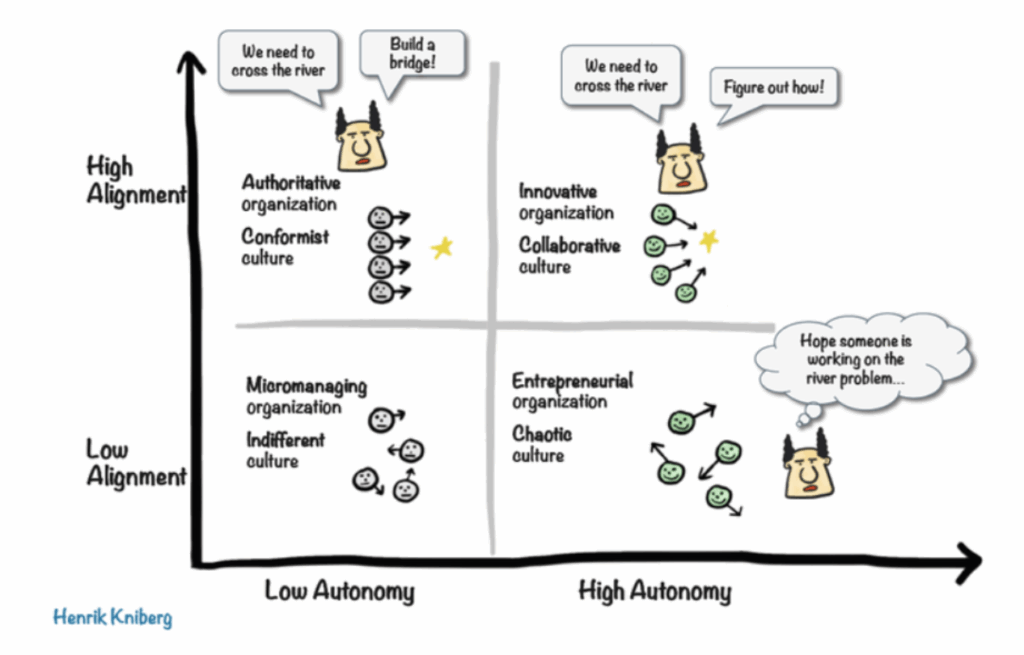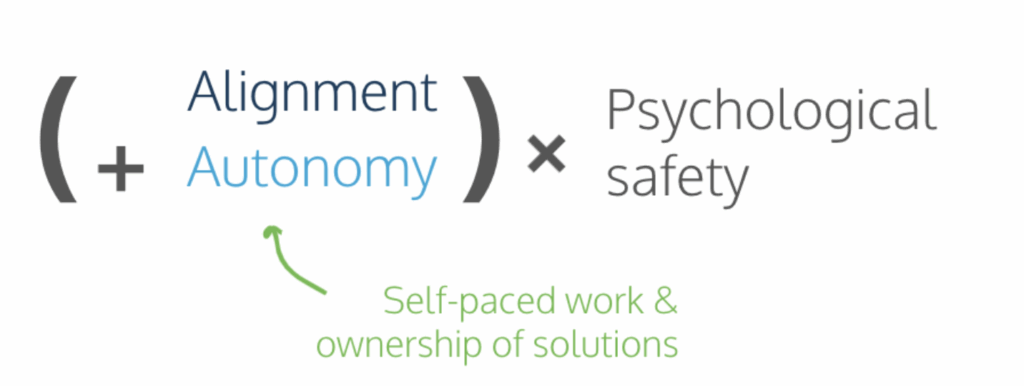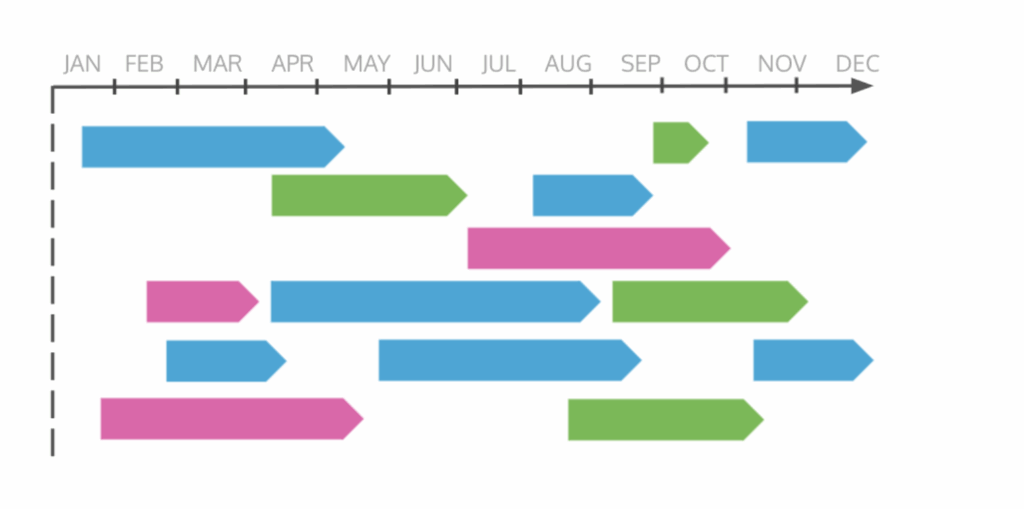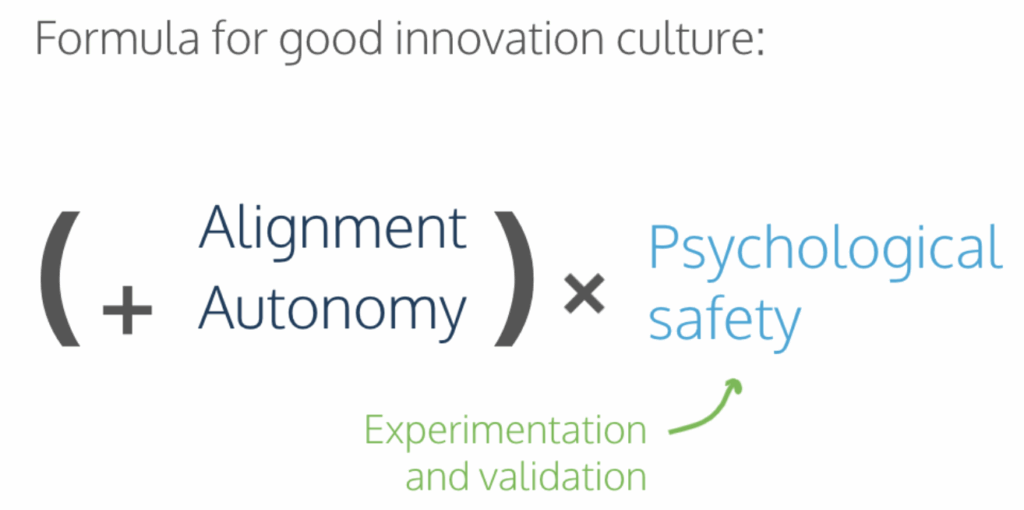The Innovation Culture Formula
Good innovation culture isn’t measured in foosball tables or beer fridges. It can’t just be painted on like an afterthought. Your company culture is made up of all the existing habits and norms that each person brings to work with them every day.
That doesn’t mean you can’t measure and improve a culture though.
The best companies have a culture that encourages novel ways to solve problems, and makes space for people to bring their best selves, and best ideas, to the table to tackle challenges. A good company culture gives life to innovation.
So what really makes up a healthy innovation culture?
Formula for strong innovation culture
I’ve previously mentioned this formula for strong innovation culture in my article on product leadership. In that, I explained about this little formula that looks at the key ingredients you need and how they work together.

You need Alignment, and you need Autonomy. But as you can see, Psychological safety is a multiplier. Good psychological safety can launch a team forward, while bad psychological safety can have a huge drag factor.
To really maximize alignment, autonomy, and psychological safety, it’s important to work as a team. Each of these important elements can only be realized when everyone works on them together.
Creating Alignment: Start with your Vision

Alignment involves setting and communicating a clear direction and objectives so that everyone heads the same way and knows what success looks like. And it starts with your vision.

If your vision isn’t agreed with your teams, go back to the drawing board.
You might recognize the above template as an elevator pitch template from Geoffrey Moore’s Crossing the Chasm, but it asks the right questions for a product vision too. Ask who are you building for, and what will set you apart?
Having a clearly communicated vision is key to alignment.
Get started with your own vision statement with our FREE vision template builder.
Continued Alignment with Objectives and Key Results

Next, outline objectives, or rather what’s important to the business? What makes it tick, and what does success look like to your company or your business unit?
These objectives aren’t meant to be prescriptive, as that would stifle innovation. Instead, they are meant to frame the innovation work to be done.
Objectives are often expressed as “Objectives and Key Results”, or OKRs. OKRs allow the business to see what important objectives and metrics need to be moved in order to be successful, and they keep everyone pointing in the right direction and within reasonable guardrails.
OKRs mean each team is able to use their collective knowledge to work out how they’ll contribute to meeting the objectives. It often results in outperforming goals and spotting gaps that otherwise go unnoticed.
Specific steps to be taken shouldn’t come as top-down instructions because this only uses a fraction of the knowledge of the team – your middle management. The real insights come when you give your team the ability to propose new ways to solve problems, using their collective resources and intelligence. After all, you’ve built an army of knowledge workers, let them use their knowledge.
It means you’re not limited by the time and insight available at the top level, and instead have a way to unlock considerably more collective intelligence from the organization as a whole.
Stay Aligned by Collaborating on Strategy
Because you make the most of your team’s knowledge, good collaboration becomes key to unlocking insights.
In this fast-changing world, we all know nothing is fixed. Your strategy and objectives are only as good as your last review. You can’t just set them once, and expect them to provide everlasting alignment.
You’ve got to be ready to adapt and learn. Fortunately, we can take a page from a well-worn book on this—prototyping.
Prototyping is key to learning and adapting
To get and keep alignment on objectives, and to make the most of the team’s collective expertise, teams should engage in what is essentially prototyping, but at the strategic level.
Prototyping is a well-known and much-used process to lay out assumptions and to learn quickly so that adaptations can be made.
It’s usually applied in software or hardware in the form of sketches or models. The prototypes themselves aren’t worth that much – they usually get scrapped after enough testing and feedback has been collected.
The value is in the prototyping process, in the conversations and the learning that comes from putting pen to paper, or being able to hold and see a representation of what the final version will be. It’s a hugely powerful tool in the Lean toolbox.
Roadmapping is prototyping for your strategy
This prototyping shouldn’t just happen at the product or feature level. A team can use their roadmap to prototype and test their strategy.
Your teams will work together to lay out their understanding of the terrain ahead, with the top-level objectives and company vision in mind – what challenges and opportunities do they each spot? What problems likely need to be solved? Their assumptions are laid out and serve as a kick-off point for discussion and learning.
You get a deeper understanding of the problems your business faces from this process and can spot new opportunities. It pulls collective knowledge to the forefront so that the resulting strategy becomes more robust, and the team gains a shared understanding of the steps ahead.
It’s not a one-time exercise – the best teams adapt regularly as an ongoing exercise. They execute the immediate strategic steps, and regularly share insights and get feedback about near and long-term strategic steps. Objectives and roadmaps are artifacts that are meant to be reviewed regularly, with new insights fed in from knowledge workers across the business, regularly adjusting course.
It’s as if the business has thousands of eyes and ears, and is built on the collective knowledge of many many smart people, while still driven towards and by the top-level objectives set by the business.
The ultimate goal is aligned autonomy: High alignment, high autonomy, where the team can work out how to collaborate and find the best solutions to meet their goals.

How do you get Autonomy?

Next up in our formula is Autonomy – giving the team some valuable space to find solutions to the problems in front of them.
Autonomy is closely linked with Alignment. After all, people need to know where they are headed, to be able to effectively find their own path there.
The presence of a good innovation culture means that the team is empowered to create their own solutions to problems presented. It means they are using their entire collective knowledge to solve problems, instead of having solutions handed to them.
To enable autonomy, remember that as a product person, it’s not your job to come up with all of the solutions. It’s your job to ask great questions. Surround yourself with your teammates who have insights into areas of the business you don’t. And, give them space to share their take on how they would tackle challenges.
Autonomy looks like this: Rather than the team members being responsible for the output matching the requirements of some solution conjured up elsewhere, they are responsible for managing their process of experimenting and finding the best solutions to problems they are assigned. They are measured on outcomes, instead of output.
Crushing autonomy
Nothing crushes innovation quite like micromanagement.
And there’s one sure sign of micromanagement in companies everywhere:
The timeline roadmap

This format has been around for years, but it sets teams up for failure!
Because of that timeline, everything you put on the roadmap always includes a due date and a time estimate.

Everyone knows that the release dates on roadmaps are made up, but not everyone thinks about the knock-on effects. These made-up release dates force developers on stressful marches to launch on time, they leave your salespeople and customers with expectations you can’t meet. Then, you end up distracted from seeing the opportunities in the market as you’re too busy building the wrong things.
It leads to unproductive and stressed teams.
To read more about how to Ditch the Timeline roadmap for good, read our guide.
What about Psychological Safety?
Having a culture of innovation requires psychological safety. It creates an environment in which the team can take risks, run experiments, and win, in the long run. In the Culture formula, psychological safety is a multiplier.

Psychological safety allows people to feel comfortable speaking up if they see something that’s not right, reporting errors and problems, and participating more fully with team collaboration.
How do you start to build psychological safety in your team?
Later we’ll talk about how to build psychological safety and how it plays out in your team and in your roadmap in tangible ways. But, the first part of this can be instilled just by changes in your language.
Remember, you know nothing.
As a product manager, it’s not up to you to have all the answers. Instead, it’s your job to focus on asking smart questions and creating an environment where your entire team feels they can contribute.
As product people, it’s often tempting to fill in the blanks and jump to conclusions, but this leaves out the opportunity to explore other potential outcomes and points of view.
It’s important to frame your thinking in a way to include others’ perspectives and insights.
Two phrases to help set the stage for psychological safety
Next time you go to frame a problem, phrase your questions to begin with “How might we…”
When we talk in terms of a team, the problem becomes something we’re tackling collectively. Rather than coming across as assertive, we’re supposing how we could solve it together. It turns the issue into a collective problem.
It also works really well if we combine “How might we….” with “I bet…..”
When working in product, it’s normal—even expected—that we’re wrong from time to time. Using the phrase “I bet” gives us permission to fail and then have another attempt.
What we’re saying is that the hypothesis was wrong, not the individual. Now that the team has established what doesn’t work, they’re free to test the next hypothesis. It’s a subtle shift in language, but these small changes can raise the level of psychological safety across the team.
Experimentation and Validation
The way you work every day has an impact on the level of psychological safety in the team. To encourage people to constantly put their best ideas forward and not fear failure, a strong ethos of experimentation and validation is important to any innovative team culture.
Your roadmap can play a role in building psychological safety
You can use your roadmap to give you an overview of progress on ongoing experiments and how they’re connected to your objectives.

This format of roadmap is unique in that it helps to frame things in a way that keeps options open for innovation.
Some roadmaps are very driven by features and dates, and set the team in a mindset of ‘What needs to be done, and by when?’.
At the end of the day, at best, that way of working will get you a lot of features, but everyone knows that a lot of features doesn’t make a better product!
A lean, experimentation-focused roadmap changes that focus.
It has the team look at what the problems are to solve and how they impact the overall business objectives, reprioritizing at that level first – never wasting time in the minutiae of prioritizing amongst a pile of ideas in a backlog.
It then asks: How might we solve this problem?
Instead of assuming the answer is a new feature to be built, an experiment has a broader context.
After all, some experiments might be to add a new feature, as that might be a good way to solve a problem and impact an objective. But you might also change or even remove a feature instead, as an experiment. That can be a great way to impact your usability-related objectives!
Some experiments might not be feature-related at all. Your team might come up with experiments that adjust pricing or packaging or positioning—change the way you talk about some features on the homepage, perhaps. Those are often lower-cost ways of having a high impact on objectives and have nothing to do with the usual feature-build mindset.
Validation with a Lean Roadmap
In addition to being used to show experimentation, your roadmap can help pave the path for proper validation of work. This helps to build psychological safety by creating an environment where the successes and failures are learned from in a healthy and productive way—not just shunted out the door like most features, forgotten about as soon as they are launched.
Just because something was released, doesn’t mean it’s automatically successful, that it’s solved the underlying problem. Instead, it should be validated, so your team knows what’s working and what’s not.
Your roadmap will help here.

Use space in your roadmap for validation. The ProdPad roadmap has this space built right in for you, with the Completed view. It gives you a space to track what was released and when, as well as to capture details on the outcome.
Did it solve the problem and impact the objective you had bet it would? You create a space to show the value of the work done by building this validation into your roadmap.
Back to the Innovation Formula!
All of these elements need to be present for a strong innovation culture:
Alignment, Automation, and Psychological Safety

Companies that have a clear vision and objectives, allow for self-paced work and ownership of solutions. And most importantly, they create space for experimentation and validation, and benefit from a workplace culture that allows them to out-innovate their competition.
Get in touch if you’d like more information or to discuss how to create a strong innovation culture within your own organization.
